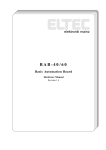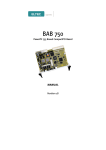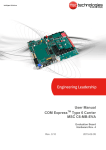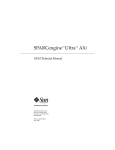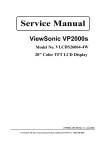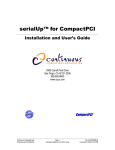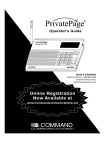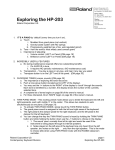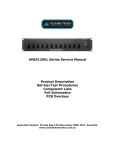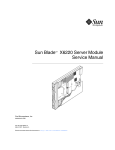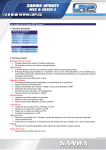Download 1 Überschrift 1 - ELTEC Elektronik AG
Transcript
BAB 740 Basic Automation Board with PowerPC 740 manual Revision 2C Revision Revision Changes Date / Name 1A First Edition, Valid for Hardware revision 1A 03.01.2000 AR 2A Valid for Hardware revision 3A 24.04.2001 G.M. 2B Valid for Hardware revision 3A Valid for Software revision W-O9B7-106C 26.09.2001 rae - I/O-Address-Map changed 2C Disclaimer new 08.11.06 hh DISCLAIMER Copyright © 2006 ELTEC Elektronik AG. The information, data, and figures in this document including respective references have been verified and found to be legitimate. In particular in the event of error they may, therefore, be changed at any time without prior notice. The complete risk inherent in the utilization of this document or in the results of its utilization shall be with the user; to this end, ELTEC Elektronik AG shall not accept any liability. Regardless of the applicability of respective copyrights, no portion of this document shall be copied, forwarded or stored in a data reception system or entered into such systems without the express prior written consent of ELTEC Elektronik AG, regardless of how such acts are performed and what system is used (electronic, mechanic, photocopying, recording, etc.). All product and company names are registered trademarks of the respective companies. Our General Business, Delivery, Offer, and Payment Terms and Conditions shall otherwise apply. Federal communications commission statement Þ This device complies with FCC Rules Part 15. Operation is subject to the following two conditions: Þ This device may not cause harmful interference, and Þ This device must accept any interference received including interference that may cause undesired operation. Þ This equipment has been tested and found to comply with the limits for a Class B digital device, pursuant to Part 15 of the FCC Rules. These limits are designed to provide reasonable protection against harmful interference in a residential installation. This equipment generates, uses and can radiate radio frequency energy and, if not installed and used in accordance with Þ Þ Þ Þ Þ manufacturer’s instructions, may cause harmful interference to radio communications. However, there is no guarantee that interference will not occur in a particular installation. If this equipment does cause harmful interference to radio or television reception, which can be determined by turning the equipment off and on, the user is encouraged to try correct the interference by one or more of the following measures: Reorient or relocate the receiving antenna. Increase the separation between the equipment and receiver. Connect the equipment to an outlet on a circuit different from that to which the receiver is connected. Consult the dealer or an experienced radio/TV technician for help. The us of shielded cables for connection of the monitor to the graphics card is required to assure compliance with FCC regulations. Changes or modifications to this unit not expressly approved by the party responsible for compliance could void the user’s authority to operate this equipment. Canadian department of communications statement Þ This digital apparatus does not exceed the Class B limits for radio noise emissions from digital apparatus set out in the Radio Interference Regulations of the Canadian Department of Communications. Þ This class B digital apparatus complies with Canadian ICES-003 SAFETY INFORMATION Electrical safety Þ To prevent electrical shock hazard, disconnect the power cable from the electrical outlet before reloading the system. Þ When adding or removing devices to or from the system, ensure that the power cables for the devices are unplugged before the signal cables are connected. If possible, disconnect all power cables from the existing system before you add device. Þ Before connecting or removing signals cables from motherboard, ensure that all power cables are unplugged. Þ Make sure that your power supply is set to the correct voltage in your area. If you are not sure about the voltage of the electrical outlet you are using, contact your local power company. Þ If the power supply is broken, do not try to fix it by yourself. Contact a qualified service technician or your retailer. Operation safety Þ Before installing the motherboard and adding devices on it, carefully read the manuals that came with the package. Þ Before using the product, make sure all cables are correctly connected and the power cables are not damaged. If you detect any damage, contact your dealer immediately. Þ To avoid short circuits, keep paper clips, screws, and staples away from connectors, slots sockets and circuitry. Þ Avoid dust, humidity, and temperature extremes. Do not place the product in any area where it may become wet. Þ Place the product on a stable surface. Þ If you encounter technical problems with the product, contact a qualified service technician or your retailer. EMC Rules This unit has to be installed in a shielded housing. If not installed in a properly shielded enclosure, and used in accordance with the instruction manual, this product may cause radio interference in which case the user may be required to take adequate measures at his or her own expense. IMPROTANT INFORMATION This product is not an end user product. It was developed and manufactured for further processing by trained personnel. RECYCLING Please recycle packaging environmentally friendly: Packaging materials are recyclable. Please do not dispose packaging into domestic waste but recycle it. Please recycle old or redundant devices environmentally friendly: Old devices contain valuable recyclable materials that should be reutilized. Therefore please dispose old devices at collection points which are suitable. User's Manual Table of Contents Table of Contents 1 Specification .................................................................... 1—1 1.1 Main Features ............................................................. 1—1 1.2 Specification Details.................................................... 1—2 1.2.1 CPU Kernel .......................................................... 1—2 1.2.2 Flash Memory....................................................... 1—2 1.2.3 PCI Devices.......................................................... 1—2 1.2.4 VMEbus Interface................................................. 1—3 1.2.5 Mechanical ........................................................... 1—3 1.2.6 I/O......................................................................... 1—3 1.2.7 Software ............................................................... 1—4 1.2.8 Compatibility......................................................... 1—4 1.2.9 Related Documents.............................................. 1—4 2 Installation........................................................................ 2—1 2.1 BAB 740 I/O ................................................................ 2—1 2.1.1 VMEbus Installation ............................................. 2—2 2.1.2 What‘s needed for Installation.............................. 2—2 2.1.3 SODIMM Installation ............................................ 2—3 2.1.4 Activity LEDs ........................................................ 2—4 BAB 740 I Table of Contents User's Manual 3 Connector Assignments ................................................. 3—1 3.1 On-board Connectors ................................................. 3—1 3.1.1 Keyboard and Mouse Connector ......................... 3—1 3.1.2 Ethernet Connector .............................................. 3—2 3.1.3 Serial Ports 1 and 2 Connectors .......................... 3—2 3.1.4 Parallel I/O Connector.......................................... 3—3 3.1.5 VMEbus Connector P1......................................... 3—4 3.2 ADAP-200 Connectors................................................ 3—6 3.2.1 8-bit SCSI ............................................................. 3—6 3.2.2 Additional I/O........................................................ 3—7 3.3 CONV-300 Connectors ............................................... 3—8 3.4 ADAP-740 Connectors................................................ 3—9 3.4.1 Floppy Disk........................................................... 3—9 3.4.2 EIDE ................................................................... 3—10 3.4.3 COM3 and COM4 .............................................. 3—11 3.4.4 Speaker .............................................................. 3—11 3.5 PMCE-740 Connectors ............................................. 3—12 3.5.1 PMCE-740 VMEbus Connector P1 .................... 3—12 3.5.2 PMCE-740 PCI Mezzanine Card Connectors.... 3—13 II BAB 740 User's Manual Table of Contents 3.5.3 PMCE-740 PCI Mezzanine Card I/O Routing .... 3—14 3.5.4 PMCE-740 Power Connector............................. 3—15 4 Board Parameters............................................................ 4—1 4.1 Host Bus...................................................................... 4—1 4.2 VMEbus....................................................................... 4—1 4.3 PCI Local Bus ............................................................. 4—4 4.4 Network ....................................................................... 4—4 4.5 SCSI............................................................................ 4—5 4.6 Serial I/O ..................................................................... 4—5 4.7 Keyboard:.................................................................... 4—5 4.8 Mouse ......................................................................... 4—6 4.9 Parallel I/O .................................................................. 4—6 4.10 MTBF Values ............................................................ 4—6 4.11 ESD Values............................................................... 4—6 4.12 Environmental Conditions ......................................... 4—6 4.13 Maximum Operating Humidity: ................................. 4—7 4.14 Power Requirements ................................................ 4—7 5 Jumpers............................................................................ 5—1 5.1 On-board Jumpers ...................................................... 5—1 BAB 740 III Table of Contents User's Manual 5.1.1 User-settable Jumpers ......................................... 5—2 5.2 PMCE-740 Jumpers.................................................... 5—5 5.2.1 PMCE-740 User-settable Jumpers ...................... 5—6 6 Booting ............................................................................. 6—1 6.1 Printout of Boot Screen............................................... 6—1 6.2 Booting OS-9 .............................................................. 6—2 6.2.1 Entering Boot Parameters.................................... 6—2 6.2.2 Printout of Boot Screen ........................................ 6—2 6.2.3 Ethernet Boot Printout.......................................... 6—3 7 Appendix .......................................................................... 7—1 7.1 Description of On-board Devices ................................ 7—1 7.1.1 SMI Ticker ............................................................ 7—1 7.1.2 Enhanced Serial Communications Controller (ESCC) ................................................................. 7—3 7.1.3 Interrupt Controller ............................................... 7—4 7.1.4 SRAM/RTC........................................................... 7—5 7.1.5 GPIO Use ............................................................. 7—6 7.1.6 Super-I/O Power-on Strappings ........................... 7—6 7.1.7 I/O Address Map .................................................. 7—7 7.1.8 Memory Address Map .......................................... 7—8 IV BAB 740 User's Manual Table of Contents 7.1.9 PCI IDSEL ............................................................ 7—9 7.2 Factory-settable Jumpers ........................................... 7—9 BAB 740 V Table of Contents User's Manual List of Tables Table 1: Activity LEDs .......................................................... 2—4 Table 2: KEYB (6-pin miniature circular connector) ............. 3—1 Table 3: MOUSE (6-pin miniature circular connector) ......... 3—1 Table 4: ETHERNET (8-pin telephone jack connector) ....... 3—2 Table 5: COM1, COM2 (9-pin min-D connector).................. 3—2 Table 6: PRN (25-pin min-D connector) ............................... 3—3 Table 7: VMEbus Connector P1 (X2001) ............................. 3—4 Table 8: Pin Assignment of Connector P2 (X2002) ............. 3—5 Table 9: SCSI Connector 8-bit X103 (on ADAP-200) .......... 3—6 Table 10: 50-Pin I/O Connector X102 (on ADAP-200)......... 3—7 Table 11: COM3, COM4 (9-pin min-D connector)................ 3—8 Table 12: Pinout Floppy Connector X101 (on ADAP-740)... 3—9 Table 13: Pinout EIDE Connector X105 (on ADAP-740) ... 3—10 Table 14: COM3 and COM4 Connectors X103 and X104 (on ADAP-740) ................................................... 3—11 Table 15: Speaker Connector X106 (on ADAP-740) ......... 3—11 Table 16: PMCE-740 VMEbus Connector P1 (X402) ........ 3—12 Table 17: PMCE-740 PCI Mezzanine Card Connectors (X101, X102, X201, X202). ................................ 3—13 VI BAB 740 User's Manual Table of Contents Table 18: PCI Mezzanine Card Back Plane I/O Routing.... 3—14 Table 19: PMCE-740 Power Connector (X403) ................. 3—15 Table 20: Boot ROM Select (J114) ...................................... 5—2 Table 21: SCSI Termination (J1601) .................................... 5—2 Table 22: SMI Interrupt Routing (J1701) .............................. 5—3 Table 23: Universe PCI Interrupt Routing (J1702...J1705) .. 5—3 Table 24: VMEBus SYSRESET (J1706, J1902) .................. 5—3 Table 25: VMEBus SYSFAIL (J1901) .................................. 5—4 Table 26: COM3 Configuration (J2201, J2202, X2201) ....... 5—4 Table 27: COM4 Configuration (J2203, J2204, X2202) ....... 5—4 Table 28: PMC Slot 1 PCIREQ and PCIGNT Routing ......... 5—6 Table 29: PMC Slot 1 Interrupt Routing ............................... 5—6 Table 30: SMI Status Register read/write............................. 7—2 Table 31: ESCC Address Assignment: ................................ 7—3 Table 32: Interrupt ................................................................ 7—5 Table 33: SRAM/RTC Address Assignment......................... 7—5 Table 34: GPIO Usage ......................................................... 7—6 Table 35: Super-I/O Wake Up Configuration:....................... 7—6 Table 36: I/O Address MAP.................................................. 7—7 BAB 740 VII Table of Contents User's Manual Table 37: Memory Address Map (default used by VxWorks) ................................... 7—8 Table 38: IDSEL Connection ................................................ 7—9 Table 39: CPU Drive Strength Configuration (J101, J102) .. 7—9 Table 40: CPU PLL Configuration (J103...J106) ................ 7—10 Table 41: System Clock (J111, J112, J113)....................... 7—10 Table 42: MPC106 PLL Configuration (J110...J107) ......... 7—11 Table 43: Cache Size (J601, J602, J603) .......................... 7—11 Table 44: Hardware Debugger Configuration (J1301) ....... 7—12 Table 45: Revision EEPROM Write Protection (J1302) ..... 7—12 VIII BAB 740 User's Manual Table of Contents List of Figures Figure 1: Block Diagram ....................................................... 1—5 Figure 2: Connection Diagram ............................................. 2—1 Figure 3: Parts Side Jumpers ............................................... 5—1 Figure 4: Solder Side Jumpers ............................................. 5—2 Figure 5: PMCE-740 Jumpers .............................................. 5—5 Figure 6: BAB 740 Interrupt Diagram ................................... 7—4 BAB 740 IX Table of Contents X BAB 740 User's Manual Specification Specification User's Manual 1 Specification 1.1 Main Features · VMEbus board with two PMC daughter card slots (opt.). Two VMEbus slots used. · PowerPC CPU 740 with 266 MHz. · RAM: 8..256 MB DRAM (2 * 64-bit SO DIMMs) EDO/SDRAM 50ns. · Cache: 512kB on-board. · PCI host bridge: Motorola MPC106. · PCI-ISA-Bridge: W83C553. · PCI-to-VME bridge Universe II for fast, global VMEbus transfers, decoupled from board-internal PCI transfers. · Flash Eprom: 2 MB onboard, Flash programmable, byte access implemented in hardware. · Network interface: Ethernet using DEC21143 (10/100 Mbps) with PCI-DMA, 10BaseT connector at front panel. · Serial synchronous (optional): 2 * RS422 / 3 Mb/s synchronous using Zilog 85230 ESCC. · Serial asynchronous: 2 * RS232 with PC97307. · Real-time clock: MK48T59 · SCSI (optional): Symbios 860 · OS-9 operating system with FasTrak cross development system. - VxWorks operating system with Tornado cross development system. · I/O-compatible with BAB-40/60 where applicable. BAB 740 1—1 Specification User's Manual Specification 1.2 Specification Details 1.2.1 CPU Kernel The CPU kernel consists of the PowerPC-740 CPU with clock rates of 266 MHz and host bus clocks of 66 MHz. The CPU contains two parallel 32-bit integer execution units with an additional floating point unit for 8 SPECint95 and 6.2 SPECfp95 at 200 MHz. It has an external second-level cache (2-1-1- 1 clocks) and main memory attached directly to the CPU’s host bus. Memory is controlled by the host bridge MPC106 which contains the bridge between host bus and on-board PCI itself as well as the memory interface for EDO or SDRAM modules in SO DIMM format (144-pin SO DIMM modules; 64-bit data bus). Memory size can be anywhere between 8 and 128 MB, depending on the DIMM modules used. Two sockets can be equipped with SO DIMM modules but the board is also running with only one module. 1.2.2 Flash Memory Up to 2 MB of user flash memory are supplied for storing usergenerated programs. Thus, diskless systems can be built. 1.2.3 PCI Devices The board-internal PCI bus is used for all I/O devices as well as the PCI-to-VME bridge. The PCI bus is of the master/slave type, capable of DMA transfers as source and target. Two single-size PMC slots allow for flexible interfacing, e.g. using a VGA display adapter PMC module and additionally a frame grabber interface. Due to the bus-master DMA capabilities of the PMC implementation of the PCI standard, frame grabber can be implemented efficiently without frame buffers. 1—2 BAB 740 Specification An Ethernet controller for either 10 Mbps or 100 Mbps Ethernet with PCI DMA capabilities is provided on-board. Front panel interface is 10/100BaseT. The last interface on the local PCI bus is the ISA bridge (Winbond W83C553), interfacing to the internal ISA bus with additional onboard components. Additionally, there are the standard PC components real-time clock, keyboard controller, dual serial I/O and parallel controller. 1.2.4 VMEbus Interface The VMEbus interface uses the Universe II bridge controller, connecting the internal PCI bus and the external VMEbus. It supports 8-, 16-, and 32-bit data transfers in master and slave mode. Additionally, bus controller (arbiter) functionality is available. Use of the BAB 740 without VMEbus is possible; only power must be supplied through VME connectors. 1.2.5 Mechanical The board format is double Eurocard (6HU) using two VMEbus slots. The VMEbus connectors are mounted at the position of the second VMEbus slot (the slot on the right) of the two slots the board is using. Two slots for single-size PMC modules are available. 1.2.6 I/O 8-bit SCSI is routed over the VME P2 connector. Additionally, the serial I/O channels 2 .... 4 and the parallel I/O are also routed via P2. On the front panel the Ethernet 10BaseT connector is located as well as the separate front panel for PMC I/O signals. The keyboard connector and two serial RS232 channel are also routed to the front panel (9-pin D connector). BAB 740 1—3 Specification User's Manual Specification User's Manual Specification 1.2.7 Software The standard operating system is OS-9/VxWorks for the PowerPC. The development environment is FasTrak for Windows, so that the user can write and debug programs on the Windows 95 or Windows NT platform. Debug and program download can be done via Ethernet or through the PCI bus. BIOS functionality is supplied in the form of the boot program, used to start the operating system OS-9/VxWorks. It also contains poweron self test routines and PCI device address setup. 1.2.8 Compatibility The BAB 740 has been designed to be software-compatible to the PowerPC reference platform (“Yellowknife”) as much as possible. 1.2.9 Related Documents PowerPC 750 Programmer's Reference: This is the CPU manufacturer's description of the PowerPC itself and the assembly language command set. 1—4 BAB 740 Specification Specification User's Manual Figure 1: Block Diagram PowerPCTM RISC Microprocessor (MPC603r, 604r, 740) 68 MHz/64 Bit Processor Bus L2 Cache PCI-/MEM-Controller (MPC106) PCI Bus Memory (SO-DIMM Sockets) 33 MHz/32 Bit PCI/PMC Slot #1 PCI to VME Bridge (Tundra Universe II) VMEbus PCI/PMC Slot #2 Ethernet Controller (DEC21143) Ethernet Interface SCSI Controller (SYM53C860) SCSI Interface IDE Interface PCI to ISA Bridge (W83C553) ISA Bus Real Time Clock (MK48T59) Enhanced Serial Comm Controller (Z85230) Super I/O Controller (PC97307) Serial #3/4 Serial #1/2 Parallel PS2 Mouse, Keyboard I2C Bus Flash EPROM (512 KB Boot) (* MB User) EEPROM (Config. Info) BAB 740 1—5 Specification User's Manual Specification 1—6 BAB 740 User's Manual Installation 2 Installation Installation 2.1 BAB 740 I/O Figure 2: Connection Diagram Status/ Control Keyboard Mouse Ethernet PMC Slot SCSI Serial #1 Serial #2 PMC I/O Serial #3 (syncron) PMC Slot Parallel I/O Serial #4 (syncron) BAB 740 2—1 Installation User's Manual 2.1.1 VMEbus Installation WARNING: Due to the power dissipation of the MPC740 CPU it is not recommended to operate the BAB 740 without forced air cooling. Installation The BAB 740 needs two VMEbus slots, when used with the PMCE carrier board. Since the two boards (BAB 740 and PMCE) have an internal connection, be sure to install resp. remove the two-board package carefully and simultaneously! 2.1.2 What‘s needed for Installation The BAB 740 must be installed into a 32-bit VMEbus rack. A terminal (or a PC with a terminal emulator program), set to 9600 baud, 8 bit, no parity, is needed to check boot messages and to change boot settings. A SCSI hard disk must be attached via an ADAP-200/220 if the operating system is booted from disk; if it is booted from Ethernet, this network connection is needed. 2—2 BAB 740 User's Manual Installation All 144-pin SO-DIMMs up to 64 MByte and some 128 Mbyte SODIMMs that fit into X701 and X702 can be used with the BAB 740. The firmware reads the type and size of the SO-DIMM from the SPD (Serial Presence Detect) EEPROM installed on the memory module. However there are some restrictions and recommendations: · SDRAMs should be 100 MHz or faster. · FPMODE or EDO RAMs should be 60 ns or faster. · X701 must be populated with a memory module. · If two memory modules are installed they should be of the same type but may have different size. Otherwise the firmware uses only the module installed in X701. · Due to performance reasons the use of SDRAM is strongly recommended (50% advantage). After reset the firmware tests the memory modules. If the test fails or the firmware reports the wrong size - the module may not be suitable for the BAB 740. BAB 740 2—3 Installation 2.1.3 SODIMM Installation Installation User's Manual 2.1.4 Activity LEDs There are four activity LEDs on the front panel of the BAB 740. The LEDs have a pulse stretcher to make short pulses visible. Installation Table 1: Activity LEDs LED RUN DISK LNK Color Green Yellow Green/Yellow ACT Yellow 2—4 Description CPU data bus in usage access to IDE or SCSI bus green = 100 Mbit link pulses present yellow = 10 Mbit link pulses present network activity BAB 740 User's Manual Connector Assignments 3 Connector Assignments Please check the connector assignments before making any connections! 3.1 On-board Connectors Connector Assignments 3.1.1 Keyboard and Mouse Connector Table 2: KEYB (6-pin miniature circular connector) Pin 1 2 3 4 5 6 Signal KBDATA nc GND +5V KBCLK nc Front View 6 5 4 3 2 1 Table 3: MOUSE (6-pin miniature circular connector) Pin 1 2 3 4 5 6 Signal MDATA nc GND +5V MCLK nc Front View 6 5 4 3 2 1 BAB 740 3—1 Connector Assignments User's Manual 3.1.2 Ethernet Connector Table 4: ETHERNET (8-pin telephone jack connector) Pin 1 2 3 4 5 6 7 8 1 Signal TXD+ TXDRXD+ nc nc RXDnc nc 8 Front View Connector Assignments 3.1.3 Serial Ports 1 and 2 Connectors Table 5: COM1, COM2 (9-pin min-D connector) Pin 1 2 3 4 5 6 7 8 9 3—2 Signal DCD RXD TXD DTR GND DSR RTS CTS RI Front View Pin 1 BAB 740 User's Manual Connector Assignments 3.1.4 Parallel I/O Connector Table 6: PRN (25-pin min-D connector) Front View 1 2 3 4 5 6 7 8 9 10 11 12 13 14 15 16 17 18-25 Signal /STROBE D1 D2 D3 D4 D5 D6 D7 D8 /ACK BUSY PE (Paper End) SLCT /AUTO FEED /ERROR /INIT /SLCT IN GND Pin 1 Connector Assignments Pin BAB 740 3—3 Connector Assignments User's Manual 3.1.5 VMEbus Connector P1 Table 7: VMEbus Connector P1 (X2001) Connector Assignments Pin 1 2 3 4 5 6 7 8 9 10 11 12 13 14 15 16 17 18 19 20 21 22 23 24 25 26 27 28 29 30 31 32 Row A D00 D01 D02 D03 D04 D05 D06 D07 GND SYSCLK GND /DS1 /DS0 /WRITE GND /DTACK GND /AS GND /IACK /IACKIN /IACKOUT AM4 A07 A06 A05 A04 A03 A02 A01 -12 V +5V Row B /BBSY /BCLR /ACFAIL /BG0IN /BG0OUT /BG1IN /BG1OUT /BG2IN /BG2OUT /BG3IN /BG3OUT /BR0 /BR1 /BR2 /BR3 AM0 AM1 AM2 AM3 GND (SERCLK) (SERDAT) GND /IRQ7 /IRQ6 /IRQ5 /IRQ4 /IRQ3 /IRQ2 /IRQ1 +5STDBY +5V Row C D08 D09 D10 D11 D12 D13 D14 D15 GND /SYSFAIL /BERR /SYSRESET /LWORD AM5 A23 A22 A21 A20 A19 A18 A17 A16 A15 A14 A13 A12 A11 A10 A09 A08 +12 V +5V Signals in parentheses are not connected 3—4 BAB 740 User's Manual Connector Assignments Table 8: Pin Assignment of Connector P2 (X2002) Signal Row A SPKROUT SCSIDB0 SCSIDB2 SCSIDB4 SCSIDB6 SCSIDBP0 SCSIDP IDEDA(0) IDEDA(1) IDEDA(2) IDEDB(13) /IDEIOCS16 /INDEX /DR1 /STEP /WGATE IDEDB(15) /SCSIACK /SCSIMSG /SCSIC/D /SCSII/O C4GND1 C4CTS C4RTS C4DCD C3GND1 C3CTS C3RTS C3DCD /WP /HDSEL DRATE0 Signal Row B +5V GND Reserved A24 A25 A26 A27 A28 A29 A30 A31 GND +5V D16 D17 D18 D19 D20 D21 D22 D23 GND D24 D25 D26 D27 D28 D29 D30 D31 GND +5V Signal Row C SCSIDB1 SCSIDB3 SCSIDB5 SCSIDB7 IDEDB(8) IDEDB(9) IDEDB(10) IDEDB(11) IDEDB(12) DENSEL /DSKCHG /MTR0 /DR0 /DIR /SCSIATN IDEDB(14) /SCSIBSY /SCSIRST /SCSISEL /SCSIREQ C4GND4 C4DTR C4TXD C4RXD C3GND4 C3DTR C3TXD C3RXD +5V /WDATA /TRK0 /RDATA Connector Assignments Pin 1 2 3 4 5 6 7 8 9 10 11 12 13 14 15 16 17 18 19 20 21 22 23 24 25 26 27 28 29 30 31 32 Lines on rows A and C are TTL-level, except Cx signals which have RS 232C level (SILC-200 used). Pin assignment changes for RS 422 configuration. Row B is reserved for 32-bit VMEbus extension BAB 740 3—5 Connector Assignments User's Manual 3.2 ADAP-200 Connectors 3.2.1 8-bit SCSI Single-ended 8-bit SCSI signals are fed into row A and C of the VMEbus P2 connector (X2002). An ADAP-200 is plugged onto the rear side of the backplane to interface to standard 8-bit SCSI connectors (a 50-pin flat cable connector) Connector Assignments If the BAB 740 is located at either end of the SCSI bus. J1601 must be installed for signal termination, otherwise J1601 must be removed. Table 9: SCSI Connector 8-bit X103 (on ADAP-200) Front View 1 Pin 2 4 6 8 10 12 14 16 18 20 22 24 26 Description DB0 DB1 DB2 DB3 DB4 DB5 DB6 DB7 DB8 GND GND GND TERM-PWR Pin 28 30 32 34 36 38 40 42 44 46 48 50 2 Description GND GND ATN GND BSY ACK RST MSG SEL CIO REQ I/O 49 50 All odd pins of the 50-pin SCSI connector except pin 25 are connected to ground. Pin 25 is left open. Pin 26 is connected to +5 V via a Shottky diode to supply power to an external SCSI terminator. 3—6 BAB 740 User's Manual Connector Assignments 3.2.2 Additional I/O Table 10: 50-Pin I/O Connector X102 (on ADAP-200) Dir I/O I O O I I O O I - Description reserved Serial Channel 4 Serial Channel 4 Serial Channel 4 Serial Channel 4 Serial Channel 4 Serial Channel 4 Serial Channel 4 not connected not connected Serial Channel 3 Serial Channel 3 Serial Channel 3 Serial Channel 3 Serial Channel 3 Serial Channel 3 Serial Channel 3 not connected not connected reserved Remark GND2 GND1 nc CTS TXD RTS RXD GND2 GND1 nc CTS TXD RTS RXD Front View 1 2 (may be changed if a non standard levelconverter board SILC is installed) Connector Assignments Pin 1..23 24 25 26 27 28 29 30 31 32 33 34 35 36 37 38 39 40 41 42..50 (may be changed if a non standard levelconverter board SILC is installed) 49 BAB 740 3—7 50 Connector Assignments User's Manual 3.3 CONV-300 Connectors Front View Pin 1 Table 11: COM3, COM4 (9-pin min-D connector) Pin Connector Assignments 1 2 3 4 5 6 7 8 9 3—8 RS232 async.Signal (default) DCD RXD TXD DTR GND nc RTS CTS nc RS232 sync.Signal DCD RXD TXD DTR GND nc TCLK RCLK nc BAB 740 RS422 async. Signal CTSRXD+ TXD+ RTSTXDnc RTS+ CTS+ RXD- RS422 sync. Signal RCLKRXD+ TXD+ TCLKTXDnc TCLK+ RCLK+ RXD- User's Manual Connector Assignments 3.4 ADAP-740 Connectors 3.4.1 Floppy Disk The floppy cable is connected between floppy drive and the adapter connector. The power supply cable for the floppy drive must be connected directly to the power supply. Pin 1 3 5 7 9 11 13 15 17 19 21 23 25 27 29 31 33 Name Gnd Gnd Gnd Gnd Gnd Gnd Gnd Gnd Gnd Gnd Gnd Gnd Gnd Gnd Gnd Gnd Gnd Name DRVDEN0 nc DRVDEN1 /INDEX /MTR0 /DS1 /DS0 MTR1 /DIR /STEP /WDATA /WGATE /TRK0 /WRTPRT /RDATA /HDSEL /DSKCHG Pin 2 4 6 8 10 12 14 16 18 20 22 24 26 28 30 32 34 BAB 740 Connector Assignments Table 12: Pinout Floppy Connector X101 (on ADAP-740) Front View 1 2 33 34 3—9 Connector Assignments User's Manual 3.4.2 EIDE Like the floppy disk drive an EIDE drive is connected with its flat cable to the adapter. The power supply cable of the EIDE device must be directly connected to the power supply. Up to two EIDE drives (harddisk, CD-ROM) can be connected. Cable length should not exceed 40 cm to avoid instable operation. EIDE is only available on board versions with EIDE option. Table 13: Pinout EIDE Connector X105 (on ADAP-740) Connector Assignments Pin 1 3 5 7 9 11 13 15 17 19 21 23 25 27 29 31 33 35 37 39 3—10 Name /RST D7 D6 D5 D4 D3 D2 D1 D0 GND REQ /IOW /IOR IORDY /ACK IRQ14 A1 A0 /CS1 /ACT Name GND D8 D9 D10 D11 D12 D13 D14 D15 nc GND GND GND nc GND nc nc A2 /CS3 GND BAB 740 Pin 2 4 6 8 10 12 14 16 18 20 22 24 26 28 30 32 34 36 38 40 Front View 1 2 39 40 User's Manual Connector Assignments 3.4.3 COM3 and COM4 Table 14: COM3 and COM4 Connectors X103 and X104 (on ADAP-740) 1 2 3 4 5 6 7 8 9 10 RS232 async. Signal (default) DCD nc RXD RTS TXD CTS DTR nc (+5V) GND nc RS232 sync. Signal RS422 async. Signal RS422 sync. Signal DCD nc RXD TCLK TXD RCLK DTR nc (+5V) GND nc CTSnc RXD+ RTS+ TXD+ CTS+ RTSRXDTXDnc RCLKnc RXD+ TCLK+ TXD+ RCLK+ TCLKRXDTXDnc Front View 1 2 9 10 The pinout of X103 and X104 on ADAP-740 is such that a crimped cable with a 10 pin edge connector and a 9 pin Min-D male connector results in the same pinout as Table 11. 3.4.4 Speaker Table 15: Speaker Connector X106 (on ADAP-740) Pin 1 2 3 4 +5V nc nc Speaker Front View 1 4 BAB 740 3—11 Connector Assignments Pin Connector Assignments User's Manual 3.5 PMCE-740 Connectors Via the PMC Extension Board (PMCE-740) the BAB 740 can be expanded by two PMC Modules. 3.5.1 PMCE-740 VMEbus Connector P1 Only GND, +5V and +12V are routed from the VMEbus Connector P1 to the Power Connector X403. No VMEbus Signals are used. Connector Assignments Table 16: PMCE-740 VMEbus Connector P1 (X402) Pin 1...8 9 10 11 12..14 15 16 17 18..30 31 32 3—12 Row A nc GND nc GND nc GND nc GND nc nc + 5 V (Cam) Row C nc GND nc nc nc nc nc nc nc + 12 V (Cam) + 5 V (Cam) BAB 740 User's Manual Connector Assignments 3.5.2 PMCE-740 PCI Mezzanine Card Connectors Table 17: PMCE-740 PCI Mezzanine Card Connectors Jn11, Jn12, Jn21, Jn22 (X101, X102, X201, X202). X101, X201 Signal Name Signal Name TCK -12V GND INTA# INTB# INTC# BUSMODE1# +5V INTD# PCI-RSVD* GND PCI-RSVD* CLK GND GND GNT' REQ# +5V V(I/O) AD(31) AD(28) AD(27) AD(25) GND GND C/BE(3)# AD(22) AD(21) AD(19) +5V V(I/O) AD(17) FRAME# GND GND IRDY# Signal +5V GND LOCK# SDONE# SBO# PAR GND V(I/O) AD(15) AD(12) AD(11) AD(9) +5V GND C/BE(0)# AD(6) AD(5) AD(4) GND V(I/O) AD(3) AD(2) AD(1) AD(0) +5V GND REQ64# Pin 2 4 6 8 10 12 14 16 18 20 22 24 26 28 30 32 34 36 38 40 42 44 46 48 50 52 54 56 58 60 62 64 Pin 1 3 5 7 9 11 13 15 17 19 21 23 25 27 29 31 33 35 37 39 41 43 45 47 49 51 53 55 57 59 61 63 X102, X202 Signal Name Signal Name +12V TRST# TMS TDO TDI GND GND PCI-RSVD PCI-RSVD* PCI-RSVD BUSMODE2# +3,3V RST# BUSMODE3# +3,3V BUSMODE4# PCI-RSVD GND AD(30) AD(29) GND AD(26) AD(24) +3,3V IDSEL AD(23) +3,3V AD(20) AD(18) GND AD(16) C/BE(2)# GND PMC-RSVD TRDY# +3,3V GND STOP# PERR# GND +3,3V SERR# C/BE(1)# GND AD(14) AD(13) GND AD(10) AD(8) 3,3V AD(7) PMC-RSVD +3,3V PMC-RSVD PMC-RSVD GND PMC-RSVD PMC-RSVD GND PMC-RSVD ACK64# +3,3V GND PMC-RSVD BAB 740 3—13 Pin 2 4 6 8 10 12 14 16 18 20 22 24 26 28 30 32 34 36 38 40 42 44 46 48 50 52 54 56 58 60 62 64 Connector Assignments Pin 1 3 5 7 9 11 13 15 17 19 21 23 25 27 29 31 33 35 37 39 41 43 45 47 49 51 53 55 57 59 61 63 Connector Assignments User's Manual 3.5.3 PMCE-740 PCI Mezzanine Card I/O Routing Table 18 shows the routing of the PMC I/O Connectors to the VMEbus P2 Connector Table 18: PCI Mezzanine Card Back Plane I/O Routing Connector Assignments (X203) Host Jn24 33 34 35 36 37 38 39 40 41 42 43 44 45 46 47 48 49 50 51 52 53 54 55 56 57 58 59 60 61 62 63 64 3—14 (X103) Host Jn14 1 2 3 4 5 6 7 8 9 10 11 12 13 14 15 16 17 18 19 20 21 22 23 24 25 26 27 28 29 30 31 32 (X401) VMEbus P2 1C 1A 2C 2A 3C 3A 4C 4A 5C 5A 6C 6A 7C 7A 8C 8A 9C 9A 10C 10A 11C 11A 12C 12A 13C 13A 14C 14A 15C 15A 16C 16A BAB 740 (X103) Host Jn14 33 34 35 36 37 38 39 40 41 42 43 44 45 46 47 48 49 50 51 52 53 54 55 56 57 58 59 60 61 62 63 64 (X401) VMEbus P2 17C 17A 18C 18A 19C 19A 20C 20A 21C 21A 22C 22A 23C 23A 24C 24A 25C 25A 26C 26A 27C 27A 28C 28A 29C 29A 30C 30A 31C 31A 32C 32A User's Manual Connector Assignments 3.5.4 PMCE-740 Power Connector Table 19: PMCE-740 Power Connector (X403) Description +5V out GND GND +12V out Connector Assignments Pin 1 2 3 4 BAB 740 3—15 Connector Assignments Connector Assignments 3—16 BAB 740 User's Manual User's Manual Board Parameters 4 Board Parameters 4.1 Host Bus 66MHz 4.2 VMEbus VMEbus interface according to specification ANSI/IEEE STD 10141987 (Rev. D1.4) VMEbus Master/Slave Capabilities: Board Parameters Single cycle: A16/A24/A32/A64:D08(EO)/D16/D32/UAT A40:D08(EO)/D16/MD32 RMW (Master only): A16/A24/A32:D08(EO)/D16/D32 A40:D08(EO)/D16/MD32 BLT: A24/A32/A64:D08(EO)/D16/D32 A40:D08(EO)/D16/MD32 MBLT: A24/A32/A64:D64 ADO: A16/A24/A32/A40/A64/CR/CSR ADOH: A16/A24/A32/A40/A64 BAB 740 4—1 Board Parameters User's Manual System Controller Options: Arbiter: BTO(16/32/64), forever IACK daisy-chain driver SYSCLK driver Arbiter Options: PRI, RRS, SGL BBSY filter Requester Options: Any one of BR(0-3) RWD, ROR, ROC Board Parameters Bus ownership timer 16 ms... 1024 ms, forever Interrupt Handler Options: IH(1-7) D08(O), D16, D32 Interrupter Options: I(1-7) D08(O), D16, D32 Auto Configuration: FSD, ASI 4—2 BAB 740 User's Manual Board Parameters Address Range: Four PCI target/VME master windows: base and size programmable, 64 KB to 4 GB window size, any of specified address capabilities or user-defined. Board Parameters Four VME slave/PCI initiator windows: base and size programmable, 64 KB to 4 GB window size, any of specified address capabilities or user-defined. BAB 740 4—3 Board Parameters User's Manual 4.3 PCI Local Bus CPU to PCI Transfer Options: Write post buffer Max. 120 MB/s (peak) PCI to Memory Transfer Options: Max. 120 MB/s (peak) Clock Speed: 33.3 MHz IRQs: Board Parameters Four PCI interrupts rerouted to selectable ISA interrupts 4.4 Network 10BaseT/100BaseTx (twisted-pair) Transfer Speed: max. 10/100 Mbit/s 4—4 BAB 740 User's Manual Board Parameters 4.5 SCSI Ultra SCSI (8 bit) Transfer Speed: asynchronous transfer 7 MB/s synchronous transfer 20 MB/s (ultra SCSI) 4.6 Serial I/O 2 Channels (PC97307): Full duplex, asynchronous Board Parameters 50 b/s - 115,2 KB/s RS232 level 2 Channels (Z85230 ESCC): Full duplex 50 b/s - 230,4 KB/s asynchronous up to 3 MB/s synchronous RS232 or RS422 level 4.7 Keyboard: MF2/AT mode PS/2 mode BAB 740 4—5 Board Parameters User's Manual 4.8 Mouse PS/2 mode Serial mouse at channel 1 or channel 2 4.9 Parallel I/O Centronics bidirectional, unbuffered TTL Transfer Rate: max. 2 MB/s 4.10 MTBF Values Includes one 64 Mbyte SODIMM: 18900 h (computed after MIL HDBK-217E) Board Parameters 253270 h (realistic value from industry stand experience) 4.11 ESD Values 2 kV (Human body method) 4.12 Environmental Conditions Storage Temperature: -40° C - +70° C (non condensing) Operating Temperature: 0° C - +50° C (1 m/s forced air cooling) 4—6 BAB 740 User's Manual Board Parameters 4.13 Maximum Operating Humidity: 85% relative 4.14 Power Requirements Total Power Requirements (without PCI extensions) 3,8 A max. 3.0 A typ. +5 VDC +/-5% 100 mA max. 30 mA typ. +12 VDC +/-10% 100 mA max. 10 mA typ. -12 VDC +/-10% Battery Board Parameters Type M4T28-BR12SH1 Approx. 8 years life time BAB 740 4—7 Board Parameters Board Parameters 4—8 BAB 740 User's Manual User's Manual Jumpers 5 Jumpers 5.1 On-board Jumpers Figure 3: Parts Side Jumpers X2001 J1706 J1301 J1705 J1704 J1703 J1702 J1701 X1301 X2201 X2202 J2203 J2201 J2204 J2202 X201 X202 X203 X204 X205 J1201 J114 J1302 J1601 J1901 J1902 X2001 S1201 S1001 X701 X2101 X1101 X1104 X1105 X1103 X1102 Jumpers X702 BAB 740 5—1 Jumpers User's Manual J107 J108 J109 J110 J111 J112 J113 J103 J104 J105 J106 J602 J601 J603 J102 J101 Figure 4: Solder Side Jumpers 5.1.1 User-settable Jumpers Table 20: Boot ROM Select (J114) J114 open Short Description Boot from Boot-ROM Boot from User-ROM (default) Jumpers Table 21: SCSI Termination (J1601) J1601 Open short 5—2 Operation disable termination enable termination (default) BAB 740 User's Manual Jumpers Table 22: SMI Interrupt Routing (J1701) J1701 1-3 2-4 4-6 3-5 7-8 Function no SMI interrupt route Universe INT0 to SMI route Universe INT0 to SMI route Universe INT0 to SMI route Universe INT0 to SMI route SMITICK to SMI (default) J1702 1-2 2-3 Function no Universe INT0, INT1 on PCI route Universe INT0 to PCI IRQ A route Universe INT1 to PCI IRQ A J1703 1-2 2-3 Function no Universe INT2, INT3 on PCI route Universe INT2 to PCI IRQ B route Universe INT3 to PCI IRQ B J1704 1-2 2-3 Function no Universe INT4, INT5 on PCI route Universe INT4 to PCI IRQ C route Universe INT5 to PCI IRQ C J1705 1-2 2-3 Function no Universe INT6, INT7 on PCI route Universe INT6 to PCI IRQ D route Universe INT7 to PCI IRQ D (default) Jumpers Table 23: Universe PCI Interrupt Routing (J1702...J1705) Table 24: VMEBus SYSRESET (J1706, J1902) J1706 short Short J1902 short Short Function no VMEbus SYSRESET VMEbus SYSRESET is input VMEbus SYSRESET is output (default) not allowed BAB 740 5—3 Jumpers User's Manual Table 25: VMEBus SYSFAIL (J1901) J1901 Open short Function no VMEbus SYSFAIL VMEbus SYSFAIL output enable (default) Table 26: COM3 Configuration (J2201, J2202, X2201) J2201 1-2 3-5 6-8 2-4 6-8 6-8 4-6 J2202 1-2 5-6 1-2 4-6 1-2 2-4 X2201 SILC-200 Configuration RS232 async. (default) SILC-200 RS232 sync. SILC-300 SILC-300 RS422 async. RS422 sync. Table 27: COM4 Configuration (J2203, J2204, X2202) J2203 1-2 3-5 6-8 2-4 6-8 6-8 4-6 J2204 1-2 5-6 1-2 4-6 1-2 2-4 X2202 SILC-200 Configuration RS232 async. (default) SILC-200 RS232 sync. SILC-300 SILC-300 RS422 async. RS422 sync. Jumpers 5—4 BAB 740 User's Manual Jumpers 5.2 PMCE-740 Jumpers R101 R102 R103 R104 X402 X102 J201 J202 J204 Figure 5: PMCE-740 Jumpers X103 X101 X401 X202 X203 X201 SLOT 0 SLOT 1 Jumpers X403 BAB 740 5—5 Jumpers User's Manual 5.2.1 PMCE-740 User-settable Jumpers Table 28: PMC Slot 1 PCIREQ and PCIGNT Routing J201 1-2 3-4 J202 1-2 3-4 Description Use PCIREQ, PCIGNT of PMC Slot 0 Use PCIREQ, PCIGNT of BAB 740 Onboard SCSI Controller Warning: PCIREQ and PCIGNT of PMC Slot 0 or SCSI Controller can only be used, if the corresponding device is not equipped! Table 29: PMC Slot 1 Interrupt Routing J204 1-2 3-4 5-6 7-8 Description Route PMC IRQ A to PCI IRQ A Route PMC IRQ A to PCI IRQ B Route PMC IRQ A to PCI IRQ C Route PMC IRQ A to PCI IRQ D Jumpers 5—6 BAB 740 User's Manual Booting 6 Booting 6.1 Printout of Boot Screen This chapter shows how the terminal screen looks like on a BAB 740 after power-on. *** ELTEC Elektronik, Mainz *** BAB-PPC Monitor Version 1.2/2 Init MPU/MSR/FPU/Segment registers. Init SuperIO (polled output on COM1). Activating 1st level cache .................... OK Setting MPC106 register ....................... OK Reading SPD of bank0/1 ........................ OK RAM-Type: SDRAM Reading SPD of bank2/3 .................... FAILED Activating 64 MByte. PowerPC 74x/75x Ver.0008 Rev.3202 at 292 / 83 MHz PCI devices on local bus ... No. VendorId DeviceId Device Class Sub-Class __________________________________________________ 00 1057 0002 Bridge device 00 0B 10AD 0565 Bridge device 01 0D 1000 000F Mass storage controller 00 0E 1011 0019 Network controller 00 13 1011 0024 Bridge device 04 Press any key to skip memory test : 65536 KByte Booting After this screen output, the standard VxWorks monitor will be started. To modify boot parameter follow the instructions provided by VxWorks development documentation. BAB 740 6—1 Booting User's Manual 6.2 Booting OS-9 6.2.1 Entering Boot Parameters The BAB 740 is prepared for booting over Ethernet using BOOTP protocol. 6.2.2 Printout of Boot Screen *** ELTEC Elektronik GmbH, Mainz *** BAB 740 Monitor Version 1.0/1 Init MPU/MSR/FPU/Segment registers. Init SuperIO (polled output on COM1). Activating 1st level cache --------------------------Setting MPC106 register -----------------------------Reading SPD of bank0/1 ------------------------------RAM-Type: SDRAM Reading SPD of bank2/3 ------------------------------Activating 32 MByte. OK OK OK FAILED OS-9000 Bootstrap for the PowerPC(tm) Ethernet 10 Mbit selected BOOTING PROCEDURES AVAILABLE -----------------------<INPUT> Boot loaded system in-place (copy User-ROM to RAM) -<bo> Boot over Ethernet (DEC 21143) ---------------------<eb> Scan SCSI devices ----------------------------------<ioi> PCI View Utility -----------------------------------<pciv> Enter ROM Debugger ---------------------------------<break> Restart the System ---------------------------------<q> Select a boot method from the above menu: (Booting procedure up to boot menu may take about half a minute in this release.) Booting 6—2 BAB 740 User's Manual Booting 6.2.3 Ethernet Boot Printout If a BOOTP server is available in the local network and the BAB 740 is known by this server, the BAB 740 will boot over Ethernet after entering ‚eb‘ at the boot menu prompt. Note: The BOOTP server must send the response directly to the BAB 740. Broadcasts will not be analyzed by the BAB 740 in this case. Select a boot method from the above menu: eb Bootp: sending bootp request for Address 00:00:5b:00:37:39 Bootp: Got Response from server: c2.00.00.38 My IP Address will be: c2.00.00.b8 My Bootfile is: /tftpboot/B740/os9boot Bootp: My bootfile size is: 00000cc3 (512-byte) blocks My subnet mask is: ff.ff.ff.00 <<no timeoffset tag>> Tftp: Sending tftp Request... ................................................................ o o o ................................................................. ................................................................. Tftp: received file with 0019840c bytes Bootfile received from server c2.00.00.38 Now searching for an OS-9000 Kernel... A valid OS-9000 bootfile was found. [1]$ Booting After the boot file is transferred, OS-9 is booting. BAB 740 6—3 Booting User's Manual Booting 6—4 BAB 740 Appendix Appendix User's Manual 7 Appendix 7.1 Description of On-board Devices This chapter describes how the on-board devices are accessed by operating system drivers. When an operating system, such as OS-9 and VxWorks, is used, there should be no need to address these devices with user-written code. 7.1.1 SMI Ticker The output of counter/timer 2 of the W83C553F may be routed to the System Management Interrupt input of the CPU when J1701 is set to position 7-8. This can be used to generate a periodic interrupt with higher priority than normal interrupts. A negative edge of the PCSpeaker output triggers the SMI when enabled via bit 7 of I/O address $809. Writing to I/O address $808 clears the SMI. BAB 740 7—1 Appendix User's Manual Appendix Table 30: SMI Status Register read/write Register SMI Status register D7 SMIPE D6 D5 D4 D3 D2 D1 D0 Read: SMISR: I/O Address: $808 SMIPE = 0: no SMI pending SMIPE = 1: SMI pending Write: Clears pending SMI Register SMI Status register D7 SMIPE D6 Write: SMICR: I/O Address: $809 ENSMI = 0: disable SMI ENSMI = 1: enable SMI 7—2 BAB 740 D5 D4 D3 D2 D1 D0 Appendix Appendix User's Manual 7.1.2 Enhanced Serial Communications Controller (ESCC) In addition to the two serial controllers COM1 and COM2 that are incorporated in the PC97307 Super-I/O the BAB 740 features another two serial lines that are realized with a Z85230 ESCC. The ESCC is clocked with 12 MHz or 14.7456 MHz. This allows transfer rates up to 3 MBaud synchronous and 230.4 KBaud asynchronous. Channel A can be operated with DMA to reduce interrupt load of the CPU for synchronous block protocols. DMA channel 0 is used for receive and Channel 1 for transmit. The DMA controller must be programmed to type A or B mode. The Interrupt request of the ESCC is connected to INT9 input of the interrupt controller. Table 31: ESCC Address Assignment: I/O Address $800 $801 $802 $803 Description ESCC Channel B Control ESCC Channel A Control ESCC Channel B Data ESCC Channel A Data BAB 740 7—3 Appendix User's Manual Appendix 7.1.3 Interrupt Controller Figure 6: BAB 740 Interrupt Diagram PowerPC INT SMI VME Timer #2 INT OUT Timer #1 INT 0 Timer #0 IDE #1 W83C553 IDE #0 PCI INT A INT B INT C INT D INT 9 INT 5 INT 1; 3..12; 14; 15 ........... PMC #1 ESCC (Z85230) PMC #2 RTC (MK48T59) Super I/O (PC97307) SCSI Network VME This diagram shows how the on-board interrupt sources are connected to the interrupt controller, located logically in the W83C553 chip. This chip then prioritizes and drives the two CPU interrupt inputs. The priority scheme used is shown below: 7—4 BAB 740 User's Manual Appendix Priority 1 2 3 4 5 6 7 8 9 10 11 12 13 14 15 ISA IRQ INT 0 INT 1 INT 8 INT 9 INT10 INT 11 INT 12 INT 13 INT 14 INT 15 INT 3 INT 4 INT 5 INT 6 INT 7 PCI IRQ INT A INT B INT C INT D Appendix Table 32: Interrupt Source Timer 0 (Ticker) Keyboard ESCC PMC #1 SCSI or PMC #2 Ethernet VME Serial #2 Serial #1 RTC Floppy Parallel Port 7.1.4 SRAM/RTC A indirect addressing scheme is used to access the M48T59Y SRAM/RTC. To access the SRAM/RTC the desired address first must be written to I/O address $70 and $71. Then the data can be accessed via I/O address $76. The interrupt output of the M48T59Y is connected with the INT5 input of the interrupt controller. It may be used to generate periodic interrupts or watchdog interrupts. Table 33: SRAM/RTC Address Assignment I/O Address $070 $071 $076 Description SRAM/RTC LSB Address SRAM/RTC MSB Address SRAM/RTC Data BAB 740 7—5 Appendix User's Manual Appendix 7.1.5 GPIO Use The GPIOs of the Super-I/O are used for the following purposes: Table 34: GPIO Usage Name GPIO10 GPIO11 GPIO12 GPIO13 GPIO14 GPIO15 GPIO16 GPIO17 Type I I I/O O I/O O - GPIO20 GPIO21 GPIO22 GPIO23 GPIO24 GPIO25 GPIO26 GPIO27 I I I I Function not used CPU Bus Speed (0 = 83 MHz; 1 = 66MHz) L2 Cache Size (0 = 256 KByte; 1 = 512KByte) I2C Data for SPD of 2nd SODIMM I2C Clock for SPD of 2nd SODIMM I2C Data for SPD of 1st SODIMM, ELTEC Revision EEPROM I2C Clock for SPD of 1st SODIMM, ELTEC Revision EEPROM not used not used not used not used not used HEX Switch LSB HEX Switch HEX Switch HEX Switch MSB 7.1.6 Super-I/O Power-on Strappings The Super-I/O wakes up in the following configuration: Table 35: Super-I/O Wake Up Configuration: Pin CFG0 CFG1 CFG3,2 BADDR1,0 SELCS 7—6 Configuration FDC, KBC and RTC inactive No X-Bus Data Buffer Clock source is 24 MHz fed via X1 Pin PnP Motherboard, Wake in Config state, Index 015Ch /CS0 on /CS0 pin BAB 740 Appendix 7.1.7 I/O Address Map After initialization the following I/O address map becomes effective: Table 36: I/O Address Map I/O Address $000-$00F $020-$021 $040-$043 $060 $061 $064 $070 $071 $076 $078-$07B $081-$082 $087 $089-$08B $092 $0A0-$0A1 $0C0-$0DE $15C $15D $220-$223 $224-$227 $278-$27F $2F8-$2FF $3F0-$3F7 $3F8-$3FF $3C2-$3C9 $3CE-$3CF $3D4-$3D5 $4D0-$4D1 $808 $809 $800 $801 $802 $803 Device W83C553F W83C553F W83C553F PC97307 W83C553F PC97307 M48T59Y M48T59Y M48T59Y W83C553F W83C553F W83C553F W83C553F W83C553F W83C553F W83C553F PC97307 PC97307 PC97307 PC97307 PC97307 PC97307 PC97307 PC97307 SM810 SM810 SM810 W83C553F MACH210 MACH210 Z85230 Z85230 Z85230 Z85230 Description DMA Controller 1 Interrupt Controller 1 Counter/Timer Keyboard Data Port B Keyboard Control SRAM/RTC LSB Address SRAM/RTC MSB Address SRAM/RTC Data BIOS Timer DMA Page DMA Page DMA Page Port 92 Interrupt Controller 2 DMA Controller 2 SuperI/O Index SuperI/O Data GPIO Port 1 GPIO Port 2 Parallel Port COM2 Floppy COM1 VGA Controller VGA Controller VGA Controller Interrupt Mode SMI Status Register SMI Control Register ESCC Channel B Control ESCC Channel A Control ESCC Channel B Data ESCC Channel A Data BAB 740 7—7 Appendix User's Manual Appendix User's Manual Appendix 7.1.8 Memory Address Map The BAB 740 uses address map B (CHRP) of the MPC106. After initialization the following address map becomes effective: Table 37: Memory Address Map (default used by VxWorks) CPU Address $0000.0000-$07FF.FFFF $0800.0000-$7FFF.FFFF $8000.0000-$F9FF.FFFF $FA00.0000-$FAFF.FFFF $F903.0000-$F903.EFFF $F904.0000-$F904.FFFF PCI Address $8000.0000-$F9FF.FFFF $FA00.0000-$FAFF.FFFF $F903.0000-$F903.EFFF $F904.0000-$F904.FFFF $FB00.0000-$FCFF.FFFF $FD00.0000-$FDFF.FFFF $FE00.0000-$FE00.FFFF $FE01.0000-$FE7F.FFFF $FE80.0000-$FE80.FFFF $FE81.0000-$FE81.FFFF $FB00.0000-$FCFF.FFFF $0000.0000-$00FF.FFFF $0000.0000-$0000.FFFF $0080.0000-$0080.FFFF $0081.0000-$0081.FFFF $FE82.0000-$FE82.FFFF $0082.0000-$0082.FFFF $FE83.0000-$FEBF.FFFF $FEC0.0000-$FEDF.FFFF $0083.0000-$00BF.FFFF CONFIG_ADDR $FEE0.0000-$FEEF.FFFF CONFIG_DATA $FEF0.0000-$FEFF.FFFF $FF00.0000-$FF7F.FFFF J114 open: $FF80.0000-$FF9F.FFFF $FFA0.0000-$FFBF.FFFF $FFC0.0000-$FFC7.FFFF $FFC8.0000-$FFFF.FFFF J114 closed: $FF80.0000-$FF87.FFFF $FF88.0000-$FFBF.FFFF $FFC0.0000-$FFDF.FFFF $FFE0.0000-$FFEF.FFFF $FFF0.0000-$FFFF.FFFF $FEF0.0000-$FEFF.FFFF - Device local RAM reserved PCI memory space PCI memory space (PMVIEW) PCI memory space (PMGRAB) PCI memory space (UniverseII) PCI memory space (VMEbus) PCI/ISA memory space PCI/ISA I/O space reserved PCI I/O space PCI I/O space (SCSI Controller) PCI I/O space (LAN Controller) PCI I/O space PCI configuration address register PCI configuration data register PCI interrupt acknowledge reserved $FF80.0000-$FF9F.FFFF $FFA0.0000-$FFBF.FFFF $FFC0.0000-$FFC7.FFFF $FFC8.0000-$FFFF.FFFF User Flash EPROM Mirrored User Flash EPROM System Flash EPROM Mirrored System Flash EPROM $FF80.0000-$FF87.FFFF $FF88.0000-$FFBF.FFFF $FFC0.0000-$FFDF.FFFF $FFE0.0000-$FFEF.FFFF $FFF0.0000-$FFFF.FFFF System Flash EPROM Mirrored System Flash EPROM User Flash EPROM 2nd MByte User Flash EPROM 2nd MByte User Flash EPROM 7—8 BAB 740 Appendix 7.1.9 PCI IDSEL The IDSEL input of each PCI device is connected to one of the PCI address/data lines for individual addressing in configuration space. Table XX shows the connection of the IDSEL signal for the various devices on the BAB 740 and the PMC carrier board. Table 38: IDSEL Connection Device Number 0 11 13 14 15 16 30 IDSEL AD(11) AD(13) AD(14) AD(15) AD(16) AD(30) Device MPC106 W83C553F SYM53C860 21143 PMC Slot 0 PMC Slot 1 Universe II Note that the device numbers differ from Intel convention where number 0 corresponds to AD(11) and number 20 corresponds to AD(31). Configuration cycles with device number 0 are handled internally in the MPC106 and therefore don‘t correspond with a address/data line. 7.2 Factory-settable Jumpers Table 39: CPU Drive Strength Configuration (J101, J102) J102 short short - J101 short short - Description disabled normal (default) strong herculean SMD jumper for factory use only Note: Implementation specific settings; do not change! BAB 740 7—9 Appendix User's Manual Appendix User's Manual Appendix Table 40: CPU PLL Configuration (J103...J106) J106 short short short short short short short short - J105 short short short short short short short short - J104 short short short short short short short short - J103 short short short short short short short short - Bus Mult. x7 bypass x2 x 6,5 x 2,5 x 4,5 x3 x 5,5 x4 x5 x6 x 3,5 off Bus Clock 25-33 60-83 25-40 50-83 33-60 40-83 25-40 33-66 (default) 25-50 25-40 40-75 off SMD jumper for factory use only Note: Implementation specific settings; do not change! Table 41: System Clock (J111, J112, J113) J111 short short short short J112 short short J113 short short short short short CPU Bus Clock 30 60 62,5 66 75 83 PCI Bus Clock 25 30 25 33 (default) 37,5 33 SMD jumper for factory use only! Note: Implementation specific settings; do not change! 7—10 BAB 740 User's Manual Appendix J110 short short short short short short short short - J109 short short short short short short short short - J108 short short short short short short short short - J107 short short short short short short short short - Mult. x1 x1 bypass x2 x2 x 2,5 x 2,5 x3 x3 off Bus Clock 33 16-25 66 33-50 83 41-50 75-100 50 - Appendix Table 42: MPC106 PLL Configuration (J110...J107) PCI Clock 33 16-25 33 (default) 16-25 33 16-20 25-33 16 - SMD jumper for factory use only Note: Implementation specific settings; do not change! Table 43: Cache Size (J601, J602, J603) J601 1-2 2-3 J602 1-2 2-3 J603 open short PCI Bus Clock 512 Cache (default) 256 Cache SMD jumper for factory use only! Note: Implementation specific settings; do not change! BAB 740 7—11 Appendix User's Manual Appendix Table 44: Hardware Debugger Configuration (J1301) J1301 1-2 2-3 Operation normal operation (default) enable COP Note: Implementation specific settings; do not change! Table 45: Revision EEPROM Write Protection (J1302) J1302 open short 7—12 Operation write protect write enable (default) BAB 740 BAB 740 Revision BAB 740 version: Memory size: Hardware revision: Serial number: BSP revision: System monitor revision: BAB 740 Configuration BAB 740 IP address: Host IP address: User name: Ftp password: Boot file: Boot configuration (ftp, bootp, ...) Host Configuration Ethernet IP address: Development tool revision (VxWorks, OS-9, ...) Operating system and revision (WinNT, ...) Error Description What must be done to reproduce the error: Editional configuration (VxWorks: config.h) Send the completed form to: ELTEC Elektronik AG Support, Mainz/Germany Phone: +49 (6131) 918-500 Fax: +49 (6131) 918-196 E-Mail: [email protected] Web: http://www.eltec.com NOTES:











































































